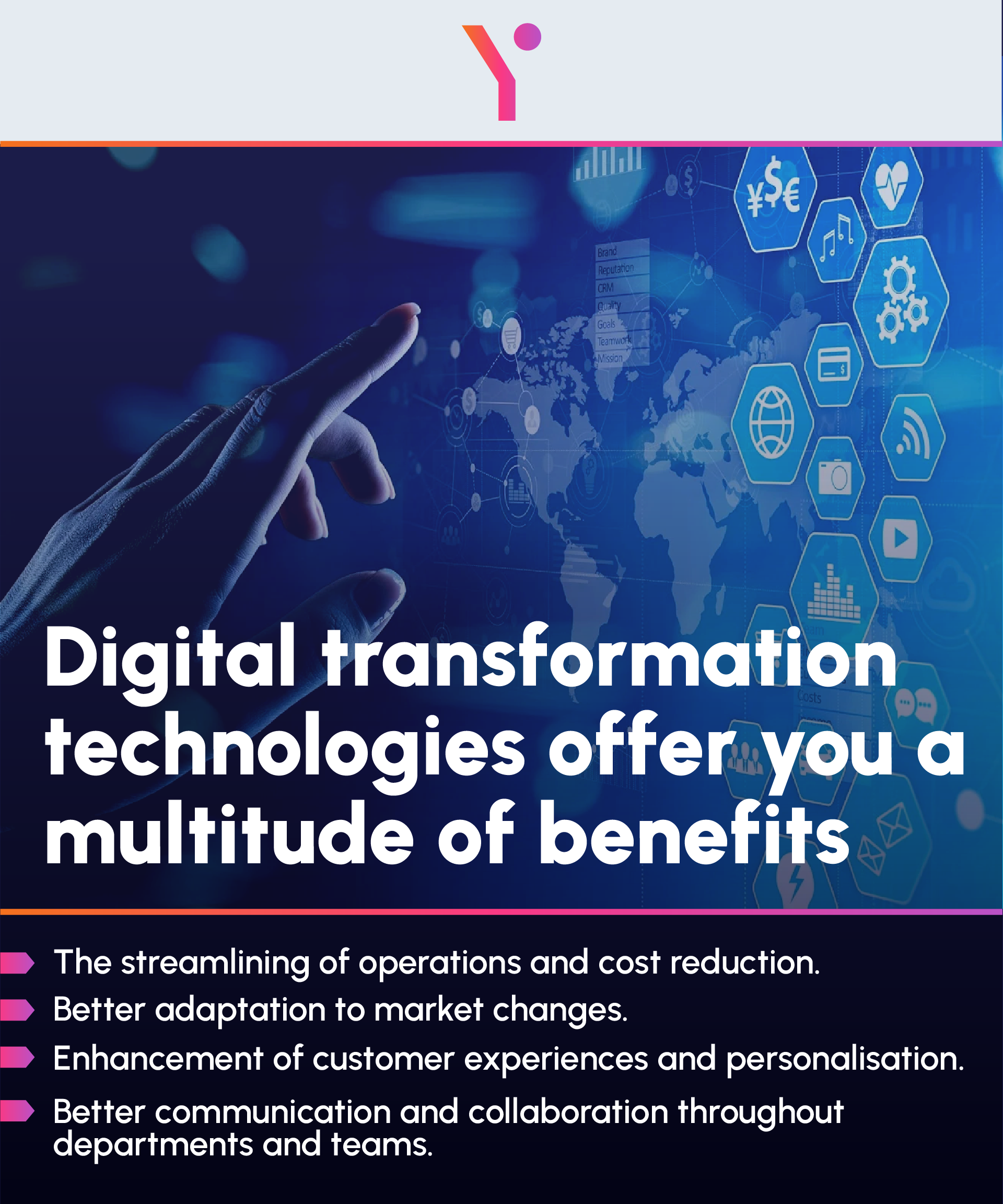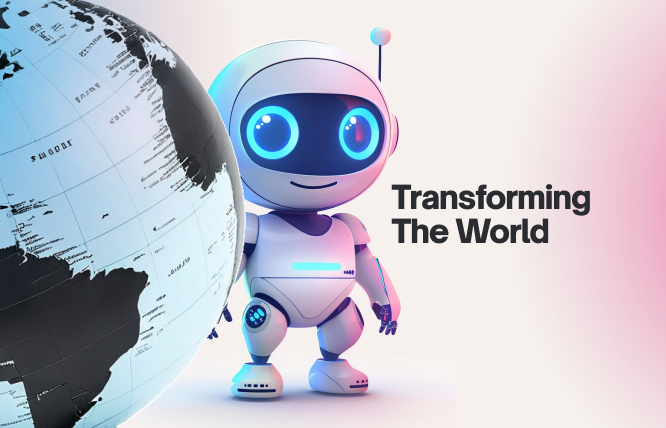Introduction
Digital Transformation Technologies are changing the world as we know it. More and more industries across the spectrum are looking to adapt it. We will discuss the top digital transformation trends in the market today and how it is impacting businesses.
It is common knowledge that the right digital transformation technologies will allow your business to enjoy new levels of success. At the same time, the wrong technology could potentially bring it down. This is exactly why a host of digital technology experts have stated that the adoption of technology greatly depends on industry trends, customer base, and the overall needs of a business.
Moving on, this blog will offer you a list of some of the most successful digital transformation technologies that are especially excellent for membership-based organisations. Perhaps after going through this article, you should take a look at a host of other similar concepts, such as enterprise technology solutions, dot net development company, mern stack development services, and an angular development company.
Defining Digital Transformation
Let’s look at what digital transformation really is. For starters, it is also known as digitalisation, and it is the proper integration of digital solutions into business processes. This is done to offer value to the customers and to harness more competitiveness. It should also be made clear here that this is not the same as digitisation as it requires culture change and innovation for a huge organisation-related transformation.
In order to attain digital transformation, there needs to be a focus on two key areas. These are:
- Cultural Change
- The Offering of Value
It must also be made clear here that the utilisation of cutting-edge technologies without offering the right value to the customers will only cause strategic and financial losses. At the same time, real transformation can never be attained without getting used to failures and challenging the existing status quo.
If you believe that this definition of digital transformation technologies has helped you then you should try to take a look at a host of other points too, which may assist you on a corporate level. This includes looking into a PHP web development company, lamp stack development company, mean stack development company, and a python development company.

Today’s Top Digital Transformation Technologies
It is generally understood that Digital Transformation (DX) integrates technology into all aspects of an organisation. It involves the leveraging of technology to enhance operations. This ultimately leads to a reduced amount of cost and waste, faster processes, better customer or member experiences, and improved decision-making.
Here are today’s leading technologies that will especially help member-based organisations pace up digital transformation:
Mobile Technology
This is generally considered to be a highly important element that drives digital transformation. According to the 18th Annual Global CEO Survey, more than 70% of CEOs believe that mobile solutions are more important than cloud computing and IoT for transformation, and more than 25% consider it as the second most important technology. It is facts such as these that showcase that almost every business leader understands the critical nature of mobile technology in digitalisation.
Mobile devices can significantly improve the frequency and speed of the interactions between customers and companies. It is in the nature of these interactions to permit access to real-time data, which is almost impossible to replicate in other ways. Also, they let marketers get valuable data to develop new markets or to grow the already present customer base. Today’s companies are making use of tools like QR Code generators to generate QR Codes that present a mobile-first experience.
It is also understood that a mobile-friendly interface is highly important for the online presence of today’s companies. For any member-based organisation, this translates into the creation of online communities, websites, and applications that are properly optimised for mobile gadgets.
Internet of Things
Also written as IoT, this has a large network of connected systems that are supposed to share and collect information without the need for manual input. It is in the nature of this technology to link device-related sensors with a centralised IoT platform, which is supposed to extract and save data from them. The data is then analysed to share important information with the specified personnel.
Generally, IoT is also utilised to identify useful data and data that can be securely discarded. Another important point to state here is that it can be utilised to suggest solutions, forecast possible issues, and identify patterns.
It is commonly observed that member-based organisations utilise IoT in combination with a host of tools, even solitarily. This is done to pace up the process of digital transformation. This happens because it can decrease costs, improve efficiency, and make a business future-proof by presenting highly innovative solutions to a group of members.
Robotics
According to the 451Alliance survey of IT professionals, one in four companies makes use of robotics to include digitisation in their activities. Unlike traditional robotics, digitisation permits interaction with humans, thereby enhancing their overall performance depending on the data that is received.
A combination of smart robotics with IoT and AI paves the way for highly effective results in companies. Additionally, they can boost efficiency, improve user experience, and enhance productivity by manifolds. A prominent example of smart robotics that is associated with member-based organisations is the utilisation of gamification technology at virtual events. This is done to enhance the experience of the attendees.
It takes into account the gaming principles in virtual meetings, and this includes points, goals, competitions, and challenges to properly engage attendees. The result here is that it acts as a very beneficial ice breaker by letting the participants converse and interchange ideas regarding how to find solutions together.
Machine Learning and Artificial Intelligence
Machine Learning and Artificial Intelligence are known to work in tandem with each other whenever there is the need to find the most appropriate digital technologies in business. Let’s first look at artificial intelligence. This is the ability of computers to properly simulate what individuals think and perform in the existing world. Generally, it is observed that Artificial Intelligence is incorporated in almost every high-end technology that we make use of, such as voice assistants, natural language processors, computer vision, and smart devices. It lets businesses (even membership organisations) conduct faster decision-making, automate tasks, and engage with customers with the assistance of chatbots.
Due to all of such facts, it is commonly observed that AI marketing is going on the rise, as it lets corporations create highly targeted campaigns and properly understand the needs of the customers in a more effective manner.
When today’s organisations make use of powerful digitalisation tools such as Artificial Intelligence and Machine Learning in their digital transformation strategies and roadmap, they enjoy a better degree of chance to attain helpful insight into data. This then allows them to carry on with highly informed decisions rather rapidly.
Augmented Reality
This is considered among highly promising new digital technologies that are being utilised by a host of industries. In simple terms, augmented reality or AR is the physical world’s virtual augmentation. This is done by including sensory stimuli, sounds, and various digital elements.
AR makes use of mobile technology in combination with real-time data. This is for the purpose of generating visual graphics. It is this integrated view that presents a unique and often highly captivating virtual glimpse of systems that assist both customers and operators in varying capacities. Many argue that one of the finest ways to make sense of AR is in product development, as AR permits entrepreneurs to properly evaluate 3D virtual models of new products. These can be modified with rather ease, and there is no need to create a prototype.
Today’s member-based organisations can utilise this technology to improve the experience of attendees during a host of public events. Furthermore, managers can showcase to the possible visitors what to anticipate at a given event. This is done by making a virtual walk-through, which relies on past event footage. Also, it can assist in the creation of a virtual brand experience during product demos for customers.
Real-Time Analytics and Big Data
Big data analytics is widely considered to be a digital technology that is capable of decoding complex data in order to showcase valuable information, like market trends, customer patterns, and any sort of unknown correlations.
Big Data’s size can have a host of ranges, such as terabytes or even zettabytes. It can be semi-structured, unstructured, or structured. It is because of the data’s complexity that traditional analysis methodologies can not properly decode the information, which allows big data to offer highly valuable real-time analysis to assist in the making of better-informed decisions.
It is observed that real-time analysis assists today’s membership organisations in a host of ways. Some of these ways are as follows:
- To take action or attain new insights, businesses can analyse and access massive amounts of data from a host of sources.
- Massive chunks of data can be both analysed and stored in a highly effective manner with storage tools and flexible data processing.
- The creation of new services and products, depending on potential risks and customer needs.
Digital Twin
This makes a virtual clone of a service or a process by using 3D modelling. This is utilised to duplicate processes that take data from stimulations for the purpose of predicting their performances. These can be connected with a host of digital transformation technologies like AI, Big Data, and IoT to drive innovation. Digital twins have four types, which are as follows:
Process Twins
They come as the digital clones of a complete operating system.
Unit Twins
Replicates a unified system that has a host of components working with each other.
Asset Twins
This simulates the interactions among at least two components.
Component Twins
These are replicas of a small functioning part of the system.
Any given venture could use at least one type of twin, and this depends on the requirements. In the case of member-based organisations, digital twins have the power to enable optimised membership journeys, data-driven insights, enhanced competitive position, and increased member trust. Moreover, it lets nonprofits efficiently process information, boost volunteer participation, improve donor personas, streamline processes, and lower operating costs.
API-Based Integrations
This is a robust technology that is used by almost every digital transformation platform. It is responsible for connecting at least two systems via their APIs in order to permit a seamless data exchange among them.
In the case where it is incorporated into a platform, it goes on to host a central hub. This is where programs are saved, depending on their API. From that point on, it goes on to maintain a dialog flow by appropriately detecting the intent requests as well as replying to them via API.
Let’s look at an example: When a system alters or creates a service, the API-based integration searches the required app from the massive database based on its API. It then goes on to integrate it into the service. As a result, it lets member-based organisations make new features or services by selecting the appropriate application from the existing unified system.
It has also been noticed that membership organisations depend on API integrations to improve productivity, sync data, and drive up revenue. Because it substitutes a host of digital tools, it prevents system disruptions, enhances workflows, and decreases overall costs.
Cloud-Based Technology
It is common knowledge that the cloud is a vital component in digital transformation that offers agility, scalability, and flexibility to organisations. The technology is known to store every data present in the cloud, finding IT experts, allowing organisations to free themselves from the trouble of downloading heavy files or manually updating their programs.
Today, one of the finest cloud technologies for managing memberships is SaaS. Any organisation that has members has the option of taking advantage of this technology. This is for the sake of automating tasks, boosting engagements, and strengthening relationships.
Final Thoughts
It is a well-understood fact that digital transformation technologies encompass a host of innovations and revolutionise industries present across the globe. Cloud computing is known to allow flexible, scalable, and cost-effective solutions, which can free businesses from a host of physical constraints. Big data analytics can harbour massive datasets and extract valuable insights to steer informed decisions. Also, AI and machine learning go on to empower automation and personalised customer experiences. IoT connects devices and attains real-time data for the purpose of enhanced control and monitoring. Virtual Reality and Augmented Reality can redefine user experiences.
Therefore, it is safe to state that the stated technologies can catalyse digital transformation. This, in turn, will continue to reshape business landscapes and enhance overall competitiveness. If you are part of an organisation that is interested in digital transformation technologies, then you should try to pay attention to a host of concepts, such as node js development company and react js development company.
Finally, if you need advice on digital transformation technologies, you may contact FuturByte. This is a well-reputed software service provider that has a globally situated client base and which is always looking to listen to potential clients.
Frequently Asked Questions
Digital transformation is considered to be a subset of business transformation. Note that business transformation is the change of the overall business strategies and processes to meet new demands and goals. Digital transformation involves the usage of digital technology to accelerate or enable these changes.
There are a host of factors that influence digital transformation’s total cost, such as the organisation’s size, business goals, and the already present technology infrastructure.
5G is known to present ultra-fast data transmission with little amounts of latency, enhancing video calls and remote work. It is important for powering IoT devices.
Have questions or feedback?
Get in touch with us and we‘l get back to you and help as soon as we can!




